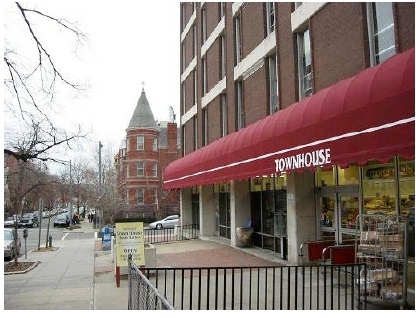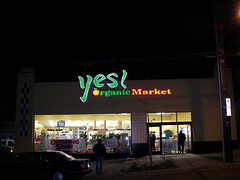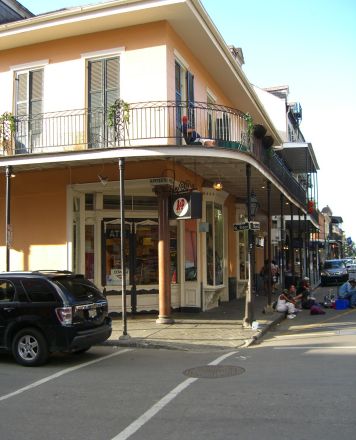Grocery s h o p p i n g in cities!
(When I write about retail I often hum the song "Shopping" by the Pet Shop Boys.)
DC1974 and I have been discussing the recent sale of the Northern California division of Albertsons. Most of the company was bought by Supervalu, locally the owner of Shoppers Food Warehouse, and the same company that is launching the Sunflower Market chain, which I have argued is a perfect supermarket chain concept for center cities, although at the moment the company seems to be focused on the Midwest. (See "The urban supermarket concept cities should be seeking out.")
He writes:
We had all kinds of urban stores in San Francisco, even Safeway had nice urban stores in SF. They had parking lots of course, but oddly enough there was always a mix of 50s style shopping centers and dense urban development in SF. The Safeway on Market Street (made famous in the Tales of the City Books and mini-series) was a beautiful midcentury shopping plaza next to the Federal Bank of San Francisco, surrounded by great transit connections, landscaped with Palm Trees and both auto and pedestrian friendly. It was a very odd mix, but somehow that seems to happen better.
Safeway stores were not quite as small as the Cala or Bell Markets or the uber expensive Real Food, or Molly's in Pacific Heights (which used to have their own mini-bus that would pick up customers and drop them off, SF elite did their own grocery shopping because you'd never want to trust that to just anyone.)
But I never had to walk more than a few blocks to go grocery shopping in the Bay Area. More than once I lived within a block of 2 full sized grocery stores, plus several specialty markets -- the goal in SF, for service employee foodies -- was to own their own market.
In fact even as I type this, I can think of about 10 other grocery stores and full-sized coops in SF. People would complain if they had to go more than a half mile to a grocery store. And that was always quickly rectified by at least 3 new markets opening up to serve the complainers. As slow as things could be out in SF, getting permits for more food stores or bars was never a difficult process -- now outdoor cafe seating? A new Starbucks? Well those could take years.
Perhaps now the East Coast is catching up.
And me:
Over the course of the 1950s and 1960s, the supermarket industry changed, first by consolidating, second by scaling up from smaller stores to larger formats, and third by focusing on the suburbs and the style of shopping there (relatively few but large shopping centers and therefore even larger stores). And they didn't seem to have many executives capable of bifurcating their identity and having different formats for the center cities.
The way you describe SF, you would be shocked to learn, is how it was in DC, mostly with Safeway, and some local companies, and the independent cooperative District Grocery Stores (DGS). I think Giant moved to a suburban focus earlier, which is why for many years it was the region's market share leader. (And regardless of how people complain about Safeway, I think they do deserve respect for never abandoning the center city, unlike most chain stores in other areas.)
Some of Safeway's smaller formats were preserved in dense areas. (For probably the same reasons that San Francisco still has many "small" grocery stores despite the changes in the industry--no space for bigger formats.)
You probably have seen the Townhouse on 19th, just north of S St. before Florida. There was another one on L St. (now a CVS), and they used an update of this format in Crystal City and Van Ness (again, areas dominated by high density apartments). But I think the 19th St. store is the last remnant. And some of the old Safeways are now independents such as Brookville in Cleveland Park.
 Safeway Townhouse, 19th Street NW. EPA photo.
Safeway Townhouse, 19th Street NW. EPA photo. Starting in the 1980s, Safeway did abandon DC's smaller format grocery store locations. This was likely due to their fighting off a hostile takeover from DC's own Haft family (the Hafts did a little greenmailing to build the family wealth portfolio). Safeway decided to have fewer differences between their regions in how stores were configured and operated. They could reduce costs and improve margins by having fewer, but larger stores. So they did.
Neighboring stores in a commercial district benefit from proximity to anchors--usually supermarkets in neighborhood districts and department stores in the central business district(downtown) and large regional subdistricts within cities, and sometimes locally owned larger stores that were a kind of neighborhood department store--because after finishing up at the primary destination people tended to shop at other stores as well. That's why supermarkets (and at one point, department stores) are called anchors. They attract customers to the entire shopping district.
Safeway's move to regional (so to speak) as opposed to neighborhood stores had a major negative impact on the city's neighborhood commercial districts, by eliminating the major generator of destination shopping. Instead of residents making frequent trips to the neighborhood district, because most households shopped at the grocery store one or twice each week, instead they were going to places like Hechinger Mall or the shopping center at 4th and Rhode Island NE, bypassing neighborhood commercial districts entirely.
(See "Grocery store necessary for walkable communities and commercial districts," and for how Walmart aims to win all of a household's retail spending, "Jumping in bed with the devil--it's hot, but will you survive the heat?)
To force this modification in household shopping patterns away from neighborhoods to more "regional" shopping destinations, reached for the most part by car, not on foot, Safeway refused to relinquish control of the leases on the abandoned smaller format spaces in order to prevent grocery stores from opening up in those spaces. They would either not lease the store at all, or they would lease it to a non-grocery store use such as a CVS (H Street) or medical uses (Capitol Hill, Brookland) etc.
Note also that these smaller spaces are more hospitable to independents. And in fact, Yes Grocery just opened up a new store in Brookland, in space that once was a Safeway.

This is why I like the fact the Chicago City Council legislated against retail chains being able to hold onto leases despite closing stores, although this kind of law needed to be around in the 1980s to have had real impact. (See "Chicago City Council proposes law making retail restrictive covenants illegal.")
Most of the larger Safeway stores you see in DC today replaced 3-6 smaller neighborhood stores. E.g., Brookland had stores at the north and south ends of 12th St. NE. H St. had stores on the 600 and 1300 blocks. There was one across the street from Eastern Market, and one on 8th and C Sts. NE (if you're ever on 8th St. over there and see a dialysis place with parking on the roof, that was the Safeway). Etc.
So what I sometimes write about Walmart--open three stores and then eventually close them all in favor of a Superwalmart in the middle, stitching up three retail trade areas into one-- started long ago with the supermarket industry. The Packer-Wrigley merger I witnessed as a child in Detroit was probably in 1970.
The problem is that one supermarket chain never adopted a counter strategy, focusing on urban-appropriate formats for center cities. The companies just wrote off the cities for the most part and focused on the suburbs. They didn't care so much because most households had access to cars, and because people had to eat, the companies knew they would still get their business.
There is still room for an urban chain that has smaller formats, without stratospheric prices. This eliminates Whole Foods on both counts!
That's why I think that Sunflower has potential. Or even the forever ailing A&P company could take what works for them in NYC, the Food Emporium chain, and transfer the learning and format to other urban settings outside of the NYC region. (See this article from Progressive Grocer, "Local Assortments, Decentralized Sourcing Mark New Food Emporium Format.")
 In New Orleans' French Quarter, across from the LaBranche House is the A&P Grocery (701 Royal Street). Image from Mitchell Publications.
In New Orleans' French Quarter, across from the LaBranche House is the A&P Grocery (701 Royal Street). Image from Mitchell Publications.For how I think urban grocery store formats should be designed and set up, see "(Urban) Grocery Shopping."
Index Keywords: retail



0 Comments:
Post a Comment
<< Home